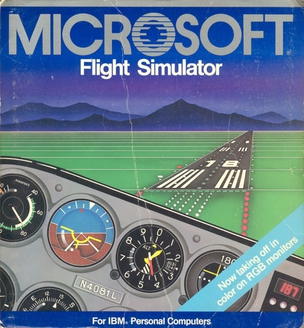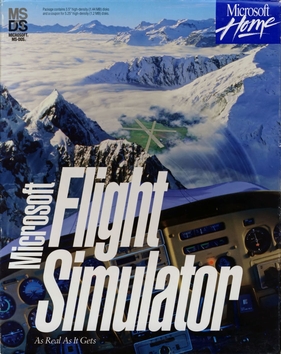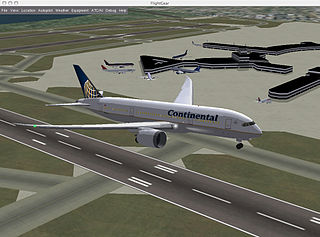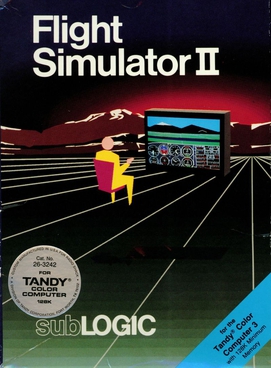
The Hercules Graphics Card (HGC) is a computer graphics controller formerly made by Hercules Computer Technology, Inc. that combines IBM's text-only MDA display standard with a bitmapped graphics mode, also offering a parallel printer port. This allows the HGC to offer both high-quality text and graphics from a single card.

Microsoft Flight Simulator is a series of flight simulator programs for MS-DOS, Classic Mac OS and Microsoft Windows operating systems. It was an early product in the Microsoft application portfolio and differed significantly from Microsoft's other software, which was largely business-oriented. As of November 2022, Microsoft Flight Simulator is the longest-running software product line for Microsoft, predating Windows by three years. Microsoft Flight Simulator is one of the longest-running PC video game series of all time.

Microsoft Flight Simulator 98, abbreviated commonly as FS98, is a flight simulator video game. It was released in September 1997 for Microsoft Windows.
Combat flight simulators are vehicle simulation games, amateur flight simulation computer programs used to simulate military aircraft and their operations. These are distinct from dedicated flight simulators used for professional pilot and military flight training which consist of realistic physical recreations of the actual aircraft cockpit, often with a full-motion platform.
Microsoft Flight Simulator began as a set of articles on computer graphics, written by Bruce Artwick throughout 1976, about flight simulation using 3-D graphics. When the editor of the magazine told Artwick that subscribers were interested in purchasing such a program, Artwick founded Sublogic Corporation to commercialize his ideas. At first the new company sold flight simulators through mail order, but that changed in January 1979 with the release of Flight Simulator (FS) for the Apple II. They soon followed this up with versions for other systems and from there it evolved into a long-running series of computer flight simulators.

GATO is a real-time submarine simulator first published in 1984 by Spectrum HoloByte for DOS. It simulates combat operations aboard the Gato-class submarine USS Growler (SS-215) in the Pacific Theater of World War II. GATO was later ported to the Apple IIe, Atari ST, and Macintosh. In 1987, Atari Corporation published a version on cartridge for the Atari 8-bit family, to coincide with the launch of the Atari XEGS.

Microsoft Flight Simulator X is a 2006 flight simulation video game originally developed by Aces Game Studio and published by Microsoft Game Studios for Microsoft Windows. It is the sequel to Microsoft Flight Simulator 2004 and the tenth installment of the Microsoft Flight Simulator series, which was first released in 1982. It is built on an upgraded graphics rendering engine, showcasing DirectX 10 features in Windows Vista and was marketed by Microsoft as the most important technological milestone in the series at the time. FSX is the first version in the series to be released on DVD media.

F29 Retaliator is a combat flight simulator video game developed by Digital Image Design and published by Ocean Software in 1989 Amiga and Atari ST, 1991 for the PC, and for the FM Towns and NEC PC-9801 in 1992-1993. Its working title was just Retaliator. The game was developed during the end of the Cold War, based mostly on speculations on then-future aircraft that were expected to be in use by the year 2002, in particular based on the design of the Lockheed Martin F-22 and the Grumman X-29A.

Microsoft Flight Simulator, commonly known as Microsoft Flight Simulator 1.0, is a flight simulator video game, released in November 1982 for the IBM PC. It is the first release in the Microsoft Flight Simulator series.

Microsoft Flight Simulator, commonly known as Microsoft Flight Simulator 2.0 or FS2, is a flight simulator video game. It was released in 1984 for the IBM PC as a self-booting disk.

Microsoft Flight Simulator, commonly known as Microsoft Flight Simulator 4.0 or FS4, is a 1989 video game developed by Bruce Artwick Organization and published by Microsoft.

Microsoft Flight Simulator, commonly known as Microsoft Flight Simulator 5.0 or FS5, is a flight simulator video game. It was released in late 1993 for the MS-DOS. A port for PC-98 was released in 1994. It was the last game in the series for DOS and the last game to appear on a non-Microsoft platform. An updated version, 5.1, was released in 1995. In November 1995, Microsoft acquired the Bruce Artwick Organization (BAO) from Bruce Artwick. Employees were moved to Redmond, Washington, and development of the series continued in-house at Microsoft.

Falcon is a combat flight simulator video game and the first official entry in the Falcon series of the F-16 jet fighter's simulators by Spectrum HoloByte. Originally developed by Sphere for Macintosh and MS-DOS in 1987 and ported to several platforms between 1988 and 1992, the game earned commercial success and critical acclaim.

A flight simulation video game refers to the simulation of various aspects of flight or the flight environment for purposes other than flight training or aircraft development. A significant community of simulation enthusiasts is supported by several commercial software packages, as well as commercial and homebuilt hardware. Open-source software that is used by the aerospace industry like FlightGear, whose flight dynamics engine (JSBSim) is used in a 2015 NASA benchmark to judge new simulation code to space industry standards, is also available for private use. A popular type of flight simulators video games are combat flight simulators, which simulate combat air operations from the pilot and crew's point of view. Combat flight simulation titles are more numerous than civilian flight simulators due to variety of subject matter available and market demand.

Jet is a combat flight simulator video game originally published in 1985 by Sublogic. The game was released in 1985 for MS-DOS and the Commodore 64, 1986 for the Apple II, 1988 for the Atari ST and Amiga, and 1989 for the Macintosh and NEC PC-9801.

Sargon III is a computer chess software. It is a sequel to Sargon II.

The American Challenge: A Sailing Simulation is a 1986 sailing simulation and racing game developed by Tom Snyder Productions and published by Mindscape. The game was noted at the time for its unique option allowing two distant players to race using computer modems.

Mickey Mouse: The Computer Game, also known as just Mickey Mouse, is an action game developed and published by Gremlin Graphics in 1988 for the Amiga, Amstrad CPC, Atari ST, Commodore 64, and ZX Spectrum.

Flight Simulator II is a video game developed by Bruce Artwick and published by Sublogic as the sequel to FS1 Flight Simulator. It was released in December 1983 for the Apple II, in 1984 for Atari 8-bit and Commodore 64, in 1986 for the Amiga and Atari ST, the Atari XEGS as a pack-in title in 1987 and in August 1988 for the Color Computer 3.

Microsoft Flight Simulator is an amateur flight simulator developed by Asobo Studio and published by Xbox Game Studios. It is an entry in the Microsoft Flight Simulator series which began in 1982, and was preceded by Microsoft Flight Simulator X in 2006. The game is a return of the series after 14 years, with development beginning six years prior to its release. It was released on August 18, 2020, for Windows, with a virtual reality (VR) version released in December of the same year as part of the free Sim 2 update. Microsoft Flight Simulator is the first game in the series to see a VR and console release, with it being released on the Xbox Series X and Series S on July 27, 2021.



















